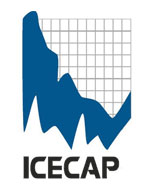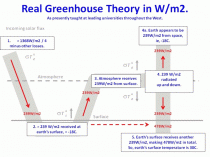By Marlo Lewis

Yesterday’s Greenwire (subscription required) reports that 11 Northeast and Mid-Atlantic states are working on a plan, modeled on California’s Low Carbon Fuel Standard (LCFS) program, to cut the carbon intensitity (CI) of motor fuels by 5%-15% over the next 15 years. The Northeast States for Coordinated Air Use Management (NESCAUM), the association of Northeast air regulatory agencies, could release the framework for the plan “as early as this month,” writes Greenwire reporter Jason Plautz.
Plautz links to a NESCAUM-authored discussion draft for “stakeholders.” After a short introductory paragraph, the document states in bold italics: “This document is not intended for distribution beyond the participating agencies and should not be cited or quoted.” Hey, I just did - so sue me!
The document never mentions the potential impact of the LCFS on fuel prices. But what else did you expect? In the “trust us, we know what’s best for the planet” world of carbon politics, affordable energy is despised, not prized.
Mandated reductions in motor fuel CI are bound to increase fuel prices. To comply with an LCFS, blenders must either modify the mix of the fuels they sell, modify their production processes, or both. If lower-carbon fuels were cheaper than gasoline, government wouldn’t need to mandate their sale, because consumers would demand them, and competition would drive energy companies to supply them. Alternative fuels must be mandated precisely because they are more expensive to produce than gasoline, reduce auto fuel economy, or face market barriers such as the massive investments required to build natural gas fueling infrastructure.
As a regional standard, the proposed LCFS would create another category of “boutique” fuels - fuel blends that vary by state and region based on regulatory specifications. Reformulating gasoline or diesel fuel to comply with such specifications increases production costs, some of which get passed on to consumers. Boutique fuels also have smaller economies of scale than standard blends. As the American Trucking Assocations says of California’s boutique diesel fuel:
California was the first state in the nation to mandate a boutique diesel fuel. Although California diesel costs only 4-5 cents extra to refine, the fuel typically sells for a 14 cent premium compared to neighboring states. This price differential is the result of higher distribution costs and reduced competition, as only a handful of refineries produce California’s boutique diesel fuel.
So would nationalizing California’s or NESCAUM’s LCFS fix the problem? Only if U.S. refineries could actually make upwards of 135 billion gallons annually of affordable low-carbon fuel. A June 2010 Charles River Associates (CRA) report analyzed the economic repercussions of a national LCFS requiring a 10% reduction in motor fuel CI from 2015 to 2025. The problem, argues CRA, is that achieving a 10% overall reduction in U.S. motor fuel CI is “beyond the reach of foreseeable technology.” Unable to comply, blenders would sell less fuel. The drop in fuel supply would drive up fuel prices by 30% to 80%, which in turn would have severe negative impacts on GDP, household purchasing power, and job creation.
Who would benefit from a Northeast LCFS? Why, the bureaucrats who design and run the program, of course. NESCAUM’s discussion draft contemplates the creation of a new “regional organization” to administer the LCFS. The program would also effectively raise taxes via “surcharges” on the sale of low-carbon credits, “alternative compliance payments,” and “transaction fees.”
So more pain at the pump, more bureaucracy, and more boodle for the “participating agencies.” Any resemblance to cap-and-trade programs living or dead is not coincidental.
By Alan Siddons
Clicking an embedded link in Discover Magazine’s polemic against Joe Bastardi will take you to Scientific American’s polemic.
----------
Icecap Note: Joe Bastardi has written this follow up to his brief Fox News interview that got under the skin of the church of global warming, now meeting in New Zealand.
------------
Here’s where Bastardi goes wrong, according to SA:
What climate science says is not that CO2 carries energy into the atmosphere or somehow magically generates it out of nowhere. Instead, it says that CO2 and other gases acts as a blanket, keeping heat from escaping into space. This, as Bastardi should know, is called the greenhouse effect.
Remember that: “keeping heat from escaping into space.”
But this is what else “climate science” will tell you:
Earth’s thermal emission with a greenhouse effect = 239 W/m²
Earth’s thermal emission without a greenhouse effect = 239 W/m²
The same.
For in greater detail, as this “science” purports to explain, the greenhouse blanket reduces the heat spilling out to space but in doing so makes the earth so hot that it spills out what it did before. In other words, the evidence we have of a blanketing effect is that there is no evidence. A blanketing effect is unobservable because the earth releases the same amount of heat with or without a blanket on. Indeed, Scientific American admits this in the very next sentence.
The Earth radiates into space roughly the same amount of energy that it receives from the sun.
So how can SA say that heat is kept from escaping? Or are we to imagine that the greenhouse effect doesn’t yet exist because it is understood to trap heat?
I don’t know why, but apparently it never occurs to a lot of people that real blankets don’t work the way they do in “climate science.” In the real world, a heated object emits infrared radiation according to its temperature. The temperature of this object will naturally be less than optimum if it’s also heating its surroundings, however. Insulation reduces such heat loss. Instead of warming the world around it, an insulated object reserves more heat for itself and thereby reaches a higher temperature. Its relative heat gain is the direct result of less heat lost to the environment.
Insulation isn’t a heat source, then; it’s merely a passive barrier that reduces the rate of loss. An insulator can only make something warmer by making something else cooler. As such, a blanketed object necessarily emits less heat than it did before. But the greenhouse blanket is obviously a different kind of blanket, for the earth radiates the same magnitude of heat with it as without, which can only mean that this blanket IS a heat source.
Those who argue for a passive greenhouse “blanket” are just kidding themselves. The real theory of the greenhouse effect can be found on many university websites. One just has to look. The actual theory makes the atmosphere a second source of heat, the first source being the sun. Here is Derek Alker’s very nice depiction of how this process is supposed to play out.
Sun-induced warmth on the earth’s surface heats up “greenhouse gases,” which thereafter turn around to heat the surface that’s heating them. In other words, if these gases absorb 239 watts per square meter from the surface, they send back the same, and increase the surface’s temperature till it’s emitting 478 watts per square meter, double the energy it got from the sun. It hardly needs saying, of course, but no laboratory experiment has ever demonstrated the existence of such a heating mechanism. No device has ever been invented to show us how this works. For such a device would defy the laws of physics.
So who is more in error - the formerly distinguished Scientific American, which clumsily contradicts itself in the gap between two sentences, proposing that the earth’s heat is simultaneously trapped and released, a queer sort of process that does indeed “magically generate energy out of nowhere”? Or Joe Bastardi for reminding us that extra energy CANNOT come out of nowhere?
This post by Dr William Happer -The Truth about Greenhouse Gases is timely response to SCIAM and Bad Astronomy/Discovery. It appears, once my favorite magazine, SCIAM has morphed to SCAM.
By David R. Legates
As the climate scare fizzles, Canada’s celebrity environmentalist resorts to ad hominem attacks
David Suzuki has never met, debated or even spoken with my colleague, scientist Willie Soon. But as more people dismiss Mr. Suzuki’s scare stories about global warming cataclysms, the more he has resorted to personal attacks against Mr. Soon and others who disagree with him.
Mr. Soon’s brilliant research into the sun’s role in climate change has helped make millions aware that carbon dioxide’s influence is far less than Mr. Suzuki wants them to think. In a recent column picked up by media outlets around North America, including Huffington Post, Mr. Suzuki attacked Mr. Soon, my fellow scientist, mostly by recycling a Greenpeace “investigation” that is itself nothing more than a rehash of tiresome (and libelous) misstatements, red herrings and outright lies. It’s time to set the record straight.
First, there’s the alleged corporate cash misrepresentation. Mr. Suzuki claims Mr. Soon received “more than $1 million over the past decade” from U.S energy companies - and implies that Mr. Soon lied to a U.S. Senate committee about the funding. In fact, the research grants were received in the years following the Senate hearing. Moreover, the Harvard-Smithsonian Center for Astrophysics took nearly half of the money (for “administration"), and what was left covered Mr. Soon’s salary, research, and other expenses including even toner for his printer.
Since Mr. Suzuki raised the subject of corporate cash, by comparison the Suzuki Foundation spends some $7 million every year on its “educational” and pressure campaigns - many of them in conjunction with various PR agencies, renewable energy companies, other foundations and environmental activist groups. Many stand to profit handsomely from Mr. Suzuki’s causes, especially “catastrophic climate change” and campaigns to replace “harmful” fossil fuels with subsidized, land-intensive, low-energy-output wind and solar facilities. Mr. Suzuki has appeared in advertisements for alternative energy sources in Ontario.
Mr. Suzuki is criticizing Mr. Soon and the Harvard-Smithsonian Institute for having done funded research - while alarmist climate catastrophe researchers share some $6 billion annually in U.S, and Canadian taxpayer money, and millions more in corporate funds, to link every natural phenomenon to global warming and promote renewable “alternatives” to fossil fuels.
If it is wrong to receive grants from organizations that have taken “advocacy” positions, then virtually every scientist with whom Mr. Suzuki has associated would be guilty. In his column Mr. Suzuki recognizes this point. “Some rightly point out that we should look at the science and now at who is paying for the research.” If he believes that the science, and not who is paying for research, is most important, then why does he continue to attack Willie Soon and others on the basis of their funding?
Second, Mr. Suzuki repeats an absurd Greenpeace claim that Mr. Soon tried to “undermine” the “peer-reviewed” work of the United Nations’ Intergovernmental Panel on Climate Change (IPCC). In reality, scientists are required to examine, review and even criticize other scientists’ research - especially when it is used to justify slashing the hydrocarbon energy on which employment, living standards and civilization depend. Indeed, the IPCC solicits reviews of its publications but is under no obligation to address any criticisms that scientists raise - in contrast to the normal peer-review process
Unfortunately, the IPCC has refused to conduct its own quality control - and has repeatedly promoted scare stories about rising seas, melting Himalayan glaciers, disappearing Amazon rainforests, more severe storms and droughts, and other disasters. By now anyone familiar with the Climategate and IPCC scandals knows these headline-grabbing claims are based on nothing more than exaggerated computer model outputs, deliberate exclusion of contrary findings, questionable air temperature station locations, and even “research” by environmental activists such as the World Wildlife Fund.
The Climategate emails made it clear that the truth was even worse. The emails paint a vivid picture of advocacy scientists strong-arming the publisher of a science journal, Climate Research, against publishing the work of Willie Soon and his associate, Sallie Baliunas. Pro-IPCC scientists threatened to boycott the journal, and intimidated or colluded with editors and grant program officers to channel funding, published only the work of advocacy scientists and rejected funding requests and publications from any scientists who disagreed with them on global warming. Mr. Suzuki’s efforts mirror their campaign - and no wonder.
The global warming scare has fizzled. The sun has entered a new “quiet” phase, and average global temperatures have been stable for 15 years. Climate conferences in Copenhagen and elsewhere have gone nowhere. Kyoto has become little more than a footnote in history. Countries that agreed to “climate stabilization” policies are retreating from that untenable position. The public realizes that climate science is far from “settled.” The climate-chaos religion is about to go the way of Baal-worship.
Most important, Canadians, Americans and Europeans alike are beginning to realize that the real dangers are not from global warming. They are from potentially cooler global temperatures that could hamstring agriculture - and from government (and Suzuki-advocated) policies that are driving energy prices so high that companies are sending jobs to Asia, and millions of families can no longer afford to heat and cool their homes, drive their cars or pay for the electricity that powers all the wondrous technologies that make our lives infinitely better, safer and healthier than even kings and queens enjoyed just a century ago.
Mr. David R. Legates is Professor of Climatology at the University of Delaware. He has worked with Mr. Willie Soon since they were the first to uncover the flaws in the so-called ‘Hockey Stick’ in 2002.




